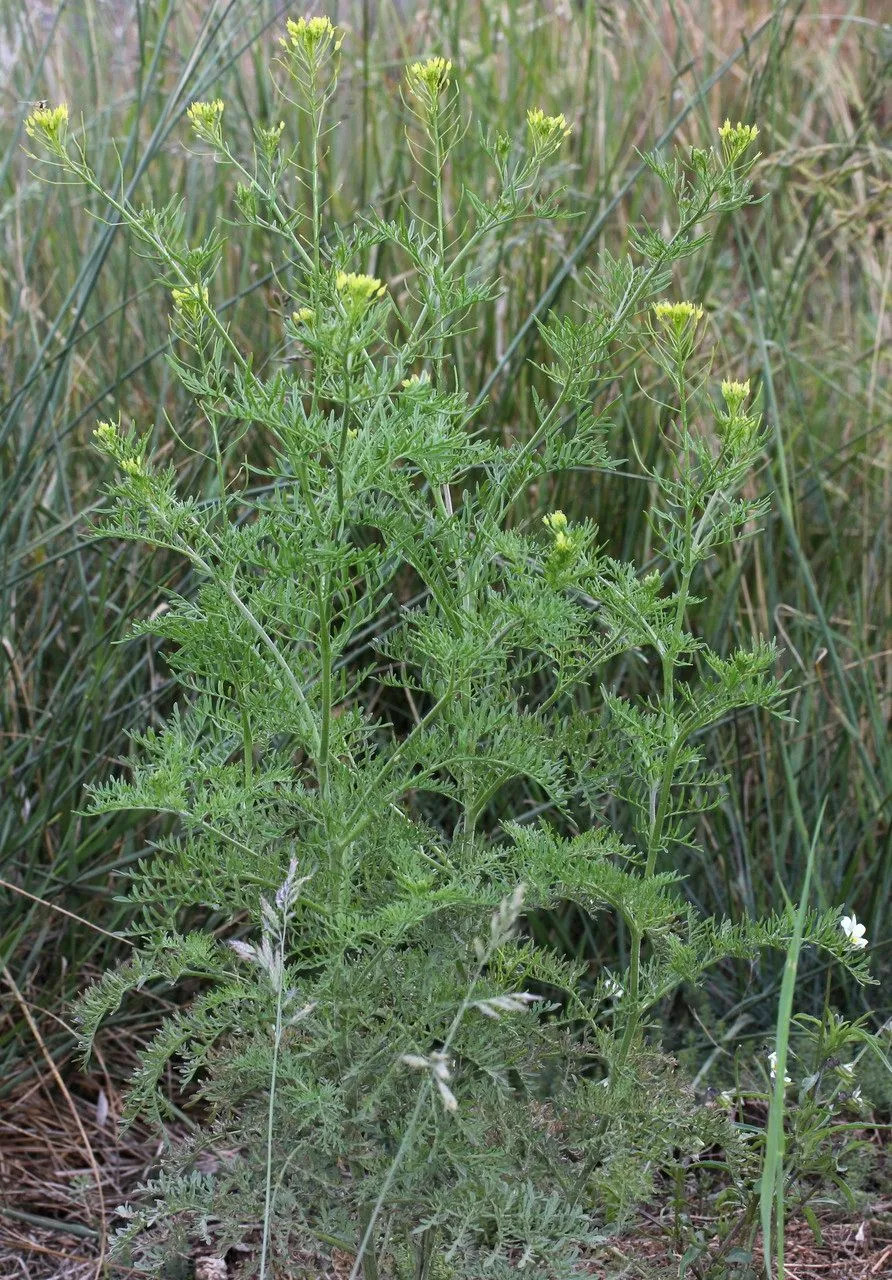
Author: (L.) Webb ex Prantl
Bibliography: H.G.A.Engler & K.A.E.Prantl, Nat. Pflanzenfam. 3(2): 192 (1892)
Year: 1892
Status: accepted
Rank: species
Genus: Descurainia
Vegetable: False
Observations: Temp. Eurasia, N. Africa
Tansy Mustard, scientifically known as Descurainia sophia, is a noteworthy member of the Brassicaceae family. Originally detailed by botanists H.G.A. Engler and K.A.E. Prantl in their 1892 publication “Nat. Pflanzenfam.,” this plant has been studied and appreciated for over a century.
Native to temperate regions of Eurasia and North Africa, Tansy Mustard has a wide distribution across diverse habitats. This adaptability has allowed it to thrive in various environments, contributing to its recognition and study by botanists and ecologists alike.
The plant itself is characterized by its finely divided leaves, which bear a resemblance to those of the common tansy, hence its name. Tansy Mustard produces small, yellow flowers grouped in clusters, typically blooming in the spring and summer months. Its seeds, encased in slender silique pods, can remain viable in the soil for many years, adding to the plant’s resilience and persistence in the wild.
Ecologically, Descurainia sophia plays a significant role in its native habitats. As a member of the mustard family, it often serves as a source of nectar for various insects, while its seeds provide food for numerous bird species. Furthermore, the Tansy Mustard’s ability to grow in disturbed soils makes it a pioneer species, helping to stabilize and restore ecosystems following environmental disruptions.
From a practical standpoint, Tansy Mustard has been utilized for both culinary and medicinal purposes throughout history. Its leaves can be used as a spice or herb, adding a distinctive flavor to dishes. Additionally, various medicinal properties have been attributed to the plant, with traditional uses ranging from treating respiratory ailments to serving as a poultice for wounds.
In summary, Descurainia sophia, or Tansy Mustard, is a versatile and ecologically important plant with a broad geographical range. Its longstanding recognition in botanical literature highlights its significance, while its adaptability and utility underscore its value in both natural and human contexts.
Dan: barberforstand, finbladet vejsennep, russisk sodaurt, ægte kastanie
Deu: besenrauke, besenrauke, sophienkraut, gewöhnliche besenrauke, sophienkraut
Eng: flaxweed tansymustard, flixweed, flixweed tansymustard, herb sophia, herb-sophia, pinnate tansymustard, tansy mustard, tansymustard, flixweed tansy mustard
Swe: fliknunneört, hålnunneört, klängnunneört, lusfrö, rysk sodaört, litutilli, stillfrö, äkta kastanj, dillsenap
Fra: descurainie sagesse, sagesse-des-chirurgiens, sagesse des chirurgiens, sagesse-des-chirurgiens
Nob: hundesennep
Nno: hundesennep
Fin: litutilli
Nld: sofiekruid
Ces: úhorník lie, úhorník mnohodílný
Cym: arfog, arfog pumdalen, berwr y fam, berwy y fam, piblys
Gla: finéal muire
En: Tansy mustard, Flixweed, Herb-Sophia, Herb Sophia, Flaxweed tansymustard, Flixweed tansymustard, Pinnate tansymustard, Tansymustard, Flixweed tansy mustard
Ca: Herba de santa Sofia
Zh: Bo niang hao
Cs: Úhorník lie, Úhorník mnohodílný
Da: Barberforstand, Finbladet vejsennep, Russisk sodaurt, Ægte kastanie
Nl: Sofiekruid
Fi: Litutilli
Fr: Sagesse des chirurgiens, Descurainie sagesse, sagesse-des-chirurgiens, Sagesse-des-chirurgiens, Herbe de sainte Sophie, Descurainie sagesse, Sisymbre sagesse
De: Besenrauke, Sophienkraut, Besenrauke, Sophienkraut, Gewöhnliche Besenrauke
He: דקורניה מנוצה
It: Erba falcona, Erba sofia
Ja: Kujira-gusa
Ko: Jaessug
Nb: Hundesennep
Nn: Hundesennep
Gd: Finéal muire
Es: Hierba de los cirujanos, Sofía
Sv: Fliknunneört, Hålnunneört, Klängnunneört, Lusfrö, Rysk sodaört, Litutilli, Stillfrö, Äkta kastanj, Dillsenap
Cy: Arfog, Arfog Pumdalen, Berwr y Fam, Berwy y Fam, Piblys
: Herb sophia
Taken Apr 28, 2021 by op Marieta (cc-by-sa)
Taken May 13, 2022 by Ornel Jokerrr83 (cc-by-sa)
Taken May 13, 2022 by Ornel Jokerrr83 (cc-by-sa)
Taken May 29, 2021 by Angela Fuer (cc-by-sa)
Taken Mar 24, 2022 by Ozoda Saminova (cc-by-sa)
Taken Jul 2, 2022 by k sch (cc-by-sa)
Taken May 14, 2022 by Miguel A. C. (cc-by-sa)
Taken May 14, 2022 by Miguel A. C. (cc-by-sa)
Taken May 9, 2022 by Fish (cc-by-sa)
Taken May 8, 2019 by Walker Lucy (cc-by-sa)
Taken May 29, 2022 by Ornel Jokerrr83 (cc-by-sa)
Taken May 9, 2022 by Fish (cc-by-sa)
Taken May 14, 2022 by Miguel A. C. (cc-by-sa)
Taken Dec 16, 2015 by EOL − Sam Kieschnick (cc-by-nc)
Taken Jul 1, 2014 by Tela Botanica − Marie PORTAS (cc-by-sa)
Taken May 3, 2014 by EOL − Steve Matson (cc-by-nc)
Taken Jun 26, 2021 by Jutta Kemmer (cc-by-sa)
Taken Jul 2, 2022 by k sch (cc-by-sa)
Taken May 29, 2022 by Ornel Jokerrr83 (cc-by-sa)
Taken Jul 1, 2014 by Tela Botanica − Marie PORTAS (cc-by-sa)
Taken Dec 29, 2013 by Tela Botanica − Pierre CROUZET (cc-by-sa)
Taken May 31, 1870 by Tela Botanica − Anne-Marie GRIMAUD (cc-by-sa)
Taken Apr 30, 1849 by Tela Botanica − Herbier PONTARLIER-MARICHAL (cc-by-sa)
Taken Jan 1, 1970 by Photoflora – L’Abbé COSTE (©)
Taken Aug 15, 2004 by Photoflora – Jean-Luc TASSET (©)
Taken May 19, 2022 by Stefana Popova (cc-by-sa)
Taken Jul 27, 2020 by Emily Bauer (cc-by-sa)
Taken Jan 14, 2016 by EOL − ellen hildebrandt (cc-by-nc)
© copyright of the Board of Trustees of the Royal Botanic Gardens, Kew.
© copyright of the Board of Trustees of the Royal Botanic Gardens, Kew.
© copyright of the Board of Trustees of the Royal Botanic Gardens, Kew.
Growth habit: Forb/herb
Ph maximum: 7.0
Ph minimum: 6.5
Light: 8
Atmospheric humidity: 4
Bloom months: [‘apr’, ‘may’, ‘jun’, ‘jul’, ‘aug’, ‘sep’]
Soil nutriments: 6
Family: Myrtaceae Author: (F.Muell.) K.D.Hill & L.A.S.Johnson Bibliography: Telopea 6: 402 (1995) Year: 1995 Status:…
Family: Rubiaceae Author: Pierre ex A.Froehner Bibliography: Notizbl. Bot. Gart. Berlin-Dahlem 1: 237 (1897) Year:…
Family: Sapindaceae Author: Koidz. Bibliography: J. Coll. Sci. Imp. Univ. Tokyo 32(1): 38 (1911) Year:…
Family: Asteraceae Author: A.Gray Bibliography: Pacif. Railr. Rep.: 107 (1857) Year: 1857 Status: accepted Rank:…
Family: Fabaceae Author: Medik. Bibliography: Vorles. Churpfälz. Phys.-Ökon. Ges. 2: 398 (1787) Year: 1787 Status:…
Family: Aspleniaceae Author: (Cav.) Alston Bibliography: Bull. Misc. Inform. Kew 1932: 309 (1932) Year: 1932…